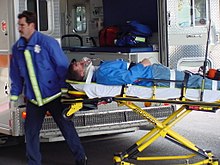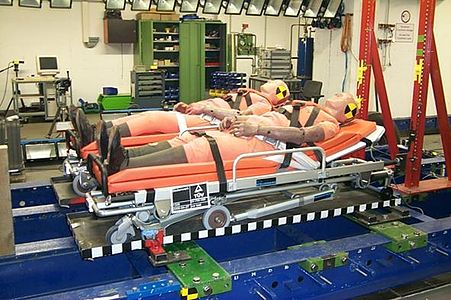Sluggish
Stretcher , also known as a stretcher , refers to a device with which a non-ambulatory person can be transported in a lying position by one or more helpers, depending on the design. Stretchers are used in particular in the rescue service and disaster control , but also, for example, in the medical services of the military . There they are used for the simple yet gentle transfer of patients . Stretchers that are equipped with a chassis are also called stretchers .
The word stretcher refers specifically to the frames on which the dead are transported ( bier ), but stretcher and stretcher are often used synonymously in colloquial language.
Ambulance service
Modern stretchers usually have a removable chassis (with rollers), which enables the stretcher to be moved by just one helper and reduces the physical strain on the helper. However, several people are still required for transport over stairs or in rough terrain. Generally, stretchers are provided with four handles for the helpers.

In modern rescue services, stretchers not only have to meet increased demands on the robustness of the material, but also on the comfort and safety of the patient. These stretchers are generally provided with padding material and also allow the additional use of a vacuum mattress or other immobilization sets . Different straps contribute to the safety of the patient during transport. In addition, it must be possible to position the head part higher than the patient's torso. As far as possible, the chassis should be able to cope with various typical situations through different possible positions, such as repositioning the patient, combating a volume deficiency shock by elevating the foot end, etc. Furthermore, there are additional infusion stands for many stretchers or device holders for defibrillators , ventilators, syringe pumps, etc. .
The needs-based disinfection and cleaning of the stretcher is important and required by state laws within Germany . Only by implementing the appropriate hygiene measures can harm to the next patient be avoided.
Norms
There are standardized versions of stretchers for some areas , for example DIN 13024 prescribes the basic requirements for stretchers in civil and disaster control . This increases the supra-regional compatibility of the auxiliary device of the units. Stretcher bars for military medical services comply with the STANAG 2040 standard . Stretchers should conform to the European standards EN 1789 and EN 1865.
The EN 1865 writes u. a. current minimum requirements for the construction of stretchers and other patient transport equipment that are used in ambulances and ambulances for the treatment and transport of patients. At the same time, EN 1789 specifies the requirements, testing and equipment for the transport and safety of patients.
An essential part of EN 1789 is a dynamic crash test in which the stretcher system is tested with an acceleration of 10 g in every direction, forwards, backwards, sideways and vertically. The safety of the patient should thus be guaranteed in the event of an ambulance accident . The testing of the stretchers with regard to their behavior in the event of a crash is carried out with the aid of a trolley which is accelerated to approx. 32 km / h and braked with a deceleration device. The g-force occurring during the deceleration places high demands on the stretcher system. The pictures show the test setup and the fixation of the stretchers on the trolley.
If a cot passes the test without violating the parameters of the test setup and does not leave the holder, it has passed the dynamic test according to EN 1789.
Other forms
- Shovel stretchers are used for the gentle, patient-friendly rescue and repositioning of trauma patients (injured people, especially if a spinal trauma is suspected) .
- So-called combination carriers combine a shovel carrier and a carrying chair . Such a stretcher can be divided in both the extended and the folded state. This means that patients can be picked up and transported while sitting.
- Grinding basket stretcher
- Scoop stretcher
- Grinding basket
- Rescue sheet
- Spineboard
- Letzi-Mobil , motorized stretcher
Manufacturer
Well-known manufacturers of stretchers for rescue services include the companies Ferno , Stryker and Stollenwerk or Pensi Rescue from Finland.
German development between 1871 and 1914
Several out of service military personnel in Lübeck devoted themselves to the further development of the medical service. They had experienced the shortcomings in 1870/71 and tried to improve them. So did u. a. Heinrich Kühne stands out here.
Every year the competence of the column and its development with the support of the local regiment was publicly demonstrated with a medical column exercise .
- Lübeck medical column
The marked wounded on the Lübeck station platform
In the middle picture, on the right, behind the crouching paramedic, is Heinrich Kühne . For example, a support frame was developed that was last demonstrated publicly in Lübeck in peacetime during the 1914 exercise - the transport was first carried out by ship, then by train. This was so convincing that the hospital trains and ships pulled into the First World War with support frames of the so-called Lübeck system .
Web links
Individual evidence
- ↑ Lifting and carrying aids in the rescue service - compilation and consideration of essential interfaces. (PDF; 6.867 MB) Federal Institute for Occupational Safety and Health, January 1, 2004, accessed on February 19, 2019 .
- ↑ Medical column exercise on the Palinger Heide. In: Father-city sheets . July 28, 1907.
- ↑ The practice run of the medical team. In: From Lübeck's towers. May 30, 1914.
- ↑ The establishment of the club hospital train. In: From Lübeck's towers . November 7, 1914.
- ↑ What the Lübeck newspapers proudly emphasized.








